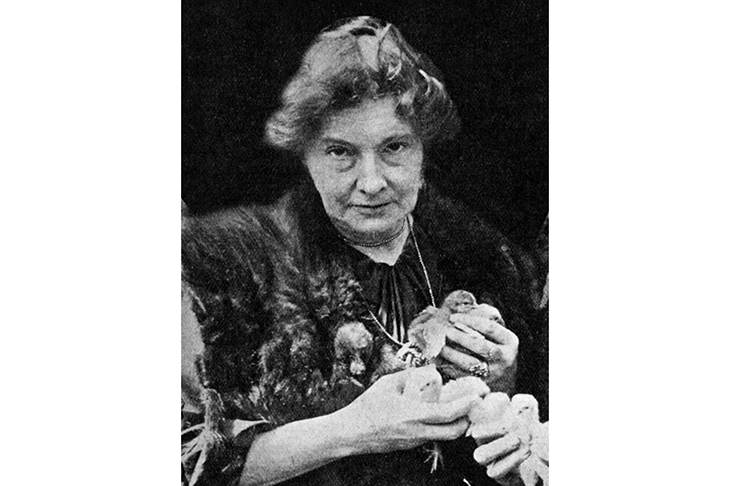‘When one writes for children,’ the novelist Jill Paton Walsh has said, ‘there are more people in the room. Writing for children involves the adult writer, and the child that writer once was; the present child reader, and the adult that child will become.’
Edith Nesbit, one of the greatest writers for children, was brilliantly attentive to this quartet. What she remembered clearly was childhood’s capacity for belief. At the moment when, in Five Children and It, the Psammead emerges from the sand, she comments: ‘It is wonderful how quickly you get used to things, even the most astonishing.’ In The Phoenix and the Carpet those same children find a mythical bird in their fireplace. They are ‘hardly astonished at all’.
Nesbit’s fairies and phoenices — how’s that for a pedantic plural? — are discovered not in a topsy-turvy Wonderland or a moral allegory but in a pet shop in Camden Town or a room in a suburban villa. In populating the recognizable world with flashes of the supernatural, she diverted the course of children’s literature. It is no surprise that J.K. Rowling, who treats magic with worldly logic, is a Nesbit devotee. Buying a uniform for wizard school? Fine, but it will need a name-tag.
Nesbit’s life (1858–1924) is a complex gift for a biographer. Passionate and impressionable, she married the journalist Hubert Bland; the couple helped to found the socialist debating club that became the Fabian Society. Nesbit’s best friend moved in as housekeeper, was promptly seduced by Hubert, and bore him two children whom Nesbit raised as her own. A vivid and unconventional matriarch of this rackety household, she gained fame as a poet and financial success as a children’s writer. After Bland’s death, she found brief happiness with a marine engineer, and cut her adopted children from her will. Who needs Bloomsbury?
Eleanor Fitzsimons’s affectionate and detailed new life of Nesbit appears more than 30 years after Julia Briggs’s A Woman of Passion (1987), which I suspect it will complement rather than supersede. Its starting point is the adult reader Fitzsimons now is, and the child reader of Nesbit she used to be. No attempt is made to resuscitate the adult fiction, but her love of the children’s literature is palpable. Some inevitable repackaging is spiced with gleanings, sourced by an assistant, from Nesbit’s archive at the University of Oklahoma. This book isn’t so much biography as bricolage, both distinguished and hampered by its research.
Fitzsimons’s writing is crowded with quotation. She clocks up nearly 60 endnotes in the first chapter, and almost 1,000 in the course of her 286 pages. Chapters 11 and 12 contain more quoted material than original narrative: the book lays out cold cuts of information rather than chronicling a life in all its complex texture. Nesbit is knowable only through others’ impressions of her, and her own impressions of herself. The deaths of her son Fabian, in 1905, and of her husband Hubert, in 1914, are among the few episodes to be told entirely in Fitzsimons’s own words. Otherwise, her prose peeks between the quotations, cool and clear, and occasionally Nesbitian: fellow Fabian Annie Besant is ‘delicate of feature’.
The Blands’ strange ménage à trois is shown from all vantage points, with Nesbit variously tolerant, coerced, temperamental or just a bit bohemian. Hubert’s more sympathetic side is carefully touched in, as are Nesbit’s fiery temper, her more conservative views (especially against female suffrage) and her own affairs of the heart with a series of devoted younger men. A seemingly unconsummated love for George Bernard Shaw, and a friendship with H.G. Wells that blew up after he seduced Nesbit’s adopted daughter, are charted in meticulous detail. The political sections by contrast dissolve in a fuzz of interchangeable Utopians. Fitzsimons is anything but sensationalist, and alive to Nesbit’s contradictions, but her priorities seemed to me askew: Nesbit’s tedious conviction that she had discovered a Baconian code in Shakespeare’s plays is covered at greater length than most of the novels.
Fitzsimons’s ability to swim around and about in her subject’s writing is illuminating, but gives the book a structural monotony. On almost every page the narrative is interrupted by a lengthy parallel from Nesbit’s fiction, as if she somehow wrote entirely in autobiographical code, with little recourse to imagination. The chronology ricochets: in the opening pages Nesbit is nine, then 38, then born, then a year old, then born once more. Three times in a single chapter we are told that she was a strong swimmer, and the pages clank with endless mentions of her bangles and cigarette-holder. Supporting characters are hard to navigate, and don’t always justify their extended portraits. Nesbit disappears during a six-page consideration of her sister’s fiancé, who then dies. And then, 60 pages later, dies again.
Lost amid the mosaics of quotation is the beating heart of Nesbit’s spirited prose, and far-from-prosaic spirit. Of the former there is no better example than the final pages of The Railway Children, a ‘realistic’ novel in which the Green Dragon train is charged with as much mythical and wish-granting resonance as any dragon in folklore. A single line, recycled from an earlier short story, has guaranteed Nesbit’s immortality: Bobbie’s ‘scream’ of ‘Oh! My Daddy, my Daddy!’ More striking than Jenny Agutter’s slow-motion run along a steaming platform is the elasticity of Nesbit’s grammar, as she switches tense and viewpoint on a knife-edge, so as to encompass character, reader and narrator, in both childhood and adulthood. All those people in the room.
This article was originally published in The Spectator’s UK magazine. Subscribe to the US edition here.



















